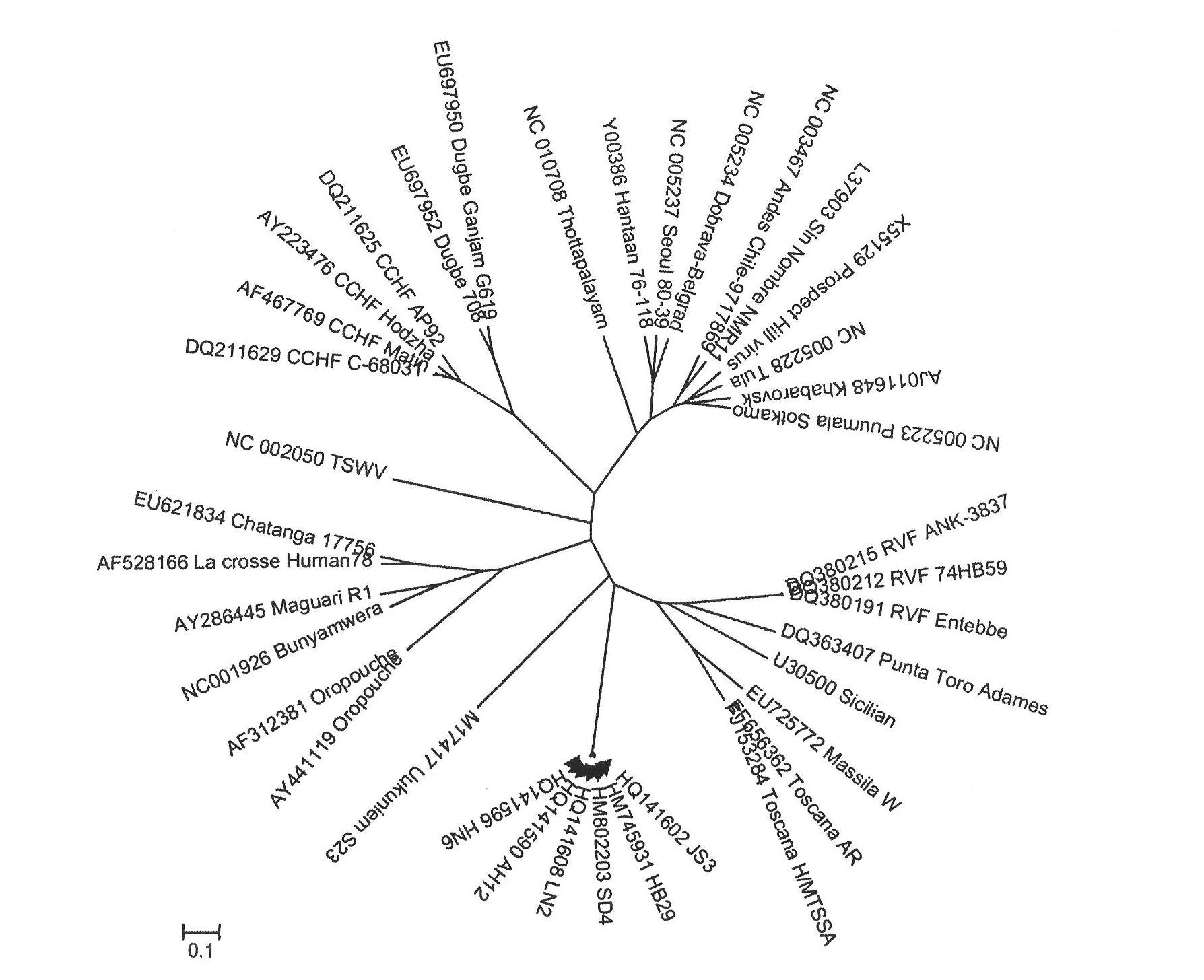Entire gene sequence of severe fever with thrombocytopenia syndrome virus (SFTSV) and application
A virus genome and syndrome technology, applied in the fields of molecular biology and virology, can solve the problem of unclear etiology of patients, and achieve the effect of huge economic and social benefits
- Summary
- Abstract
- Description
- Claims
- Application Information
AI Technical Summary
Problems solved by technology
Method used
Image
Examples
Embodiment 1
[0053] Example 1 Virus Isolation
[0054] Since 2004, Zhejiang, Jiangsu, Anhui, Shandong, Henan, Hubei and other provinces have discovered and reported cases of infectious diseases with fever and thrombocytopenia as the main manifestation, and a small number of severe patients developed multiple organ damage and even died. In 2010 Since May 2009, the National CDC Institute of Viral Diseases has collected 197 serum samples from patients with similar symptoms from 6 provinces including Shandong, Hubei, Henan, Jiangsu, Anhui and Liaoning.
[0055] Using conventional tissue culture methods, 197 samples from the above-mentioned 6 provinces were tested for virus isolation. Dilute 100μL of patient serum with DMEM 1:10 to 1ml, inoculate to 25cm 2 In the culture flask vero cells (Greiner Bio-One), adsorb for 1 hour at 37°C, add 4ml DMEM maintenance solution (containing 2% fetal bovine serum and 1000 units / mL penicillin and streptomycin), and place the culture flask at 37°C , 5% CO 2...
Embodiment 2
[0057] Embodiment 2 sequence independent single primer amplification (SISPA)
[0058] Amplification of viral nucleic acid from serum was according to the method of Allander et al. (2001) with some modifications. Firstly, the first acute serum sample HB29 obtained in 2010 was processed: 140 μL of serum was diluted twice with PBS (pH 7.4), centrifuged at 10,000 g for 10 minutes to remove cell debris, and filtered through a filter membrane with a pore size of 0.2 μm Remove cell clumps or bacteria, then add 14U DNase (Ambion), 20U benzonase nuclease (Novagen) and 20U RNase (Promega) to the serum, use 1×DNase buffer (Ambion) as the buffer, and digest at 37°C 2 hours to remove non-viral (no viral particle protection) nucleic acids. Using the Viral RNA Isolation Kit (Qiagen), RNA was extracted from 280 μL of diluted serum according to the instructions and eluted with 40 μL of RNase-free water. Synthesis of first-strand cDNA: Add 2 μL of 10 μM random primers (Promega) to 13 μL of pu...
Embodiment 3
[0065] Embodiment 3 Amplification of the full-length genome of the virus
[0066] Primers were designed according to the sequence originally obtained by SISPA, and forward and reverse primers (Table 2) for RT-PCR were designed from two adjacent fragments to obtain the sequence between the two adjacent fragments. RNA was extracted from patient serum using a viral RNA isolation kit (Qiagen), reverse transcription was performed using a cDNA synthesis kit (Invitrogen, Carlsbad, CA, USA), and amplification was performed using DNA polymerase (Invitrogen), 1.2% agarose gel electrophoresis, DNA gel recovery kit (Qiagen) was used to recover the amplified products, and PCR primers were used for direct sequencing without cloning, and the measured sequences were spliced by DNAStar software.
[0067] In order to determine the sequence of the 3' and 5' ends of the viral genome, rapid amplification of cDNA ends (RACE) was performed, and the operation was carried out according to the kit i...
PUM
| Property | Measurement | Unit |
|---|---|---|
| diameter | aaaaa | aaaaa |
| diameter | aaaaa | aaaaa |
| pore size | aaaaa | aaaaa |
Abstract
Description
Claims
Application Information
 Login to View More
Login to View More - R&D
- Intellectual Property
- Life Sciences
- Materials
- Tech Scout
- Unparalleled Data Quality
- Higher Quality Content
- 60% Fewer Hallucinations
Browse by: Latest US Patents, China's latest patents, Technical Efficacy Thesaurus, Application Domain, Technology Topic, Popular Technical Reports.
© 2025 PatSnap. All rights reserved.Legal|Privacy policy|Modern Slavery Act Transparency Statement|Sitemap|About US| Contact US: help@patsnap.com



